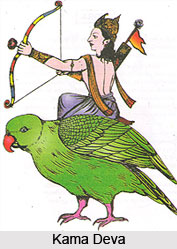 Kama Deva is held to be the god of love according to Hindu mythology. He is also known by other names like Ragavrinta, Ananga, Kandarpa, Manosij, Mandana, Ratikanta, Pushpavan and Pushpadhanva. He is portrayed in Hindu philosophy as a young and handsome winged man with bow and arrow in his hand. His bow is made of sugarcane, strung with a string of honeybees, and his arrows are decorated with five kinds of fragrant flowers. He is accompanied with a cuckoo, parrot, humming bees, the season of spring, and the gentle breeze. All these symbolizes the joyful spring season when everyplace is filled with happiness.
Kama Deva is held to be the god of love according to Hindu mythology. He is also known by other names like Ragavrinta, Ananga, Kandarpa, Manosij, Mandana, Ratikanta, Pushpavan and Pushpadhanva. He is portrayed in Hindu philosophy as a young and handsome winged man with bow and arrow in his hand. His bow is made of sugarcane, strung with a string of honeybees, and his arrows are decorated with five kinds of fragrant flowers. He is accompanied with a cuckoo, parrot, humming bees, the season of spring, and the gentle breeze. All these symbolizes the joyful spring season when everyplace is filled with happiness.
There are various myths surrounding him. He helped Parvati to catch the attention of Shiva. In order to help her; he shot his arrows-of -desire at Shiva in order to distract him in his meditation. However Lord Shiva was enraged. He opened his dreadful third eye and reduced him into ashes with a single glance. However on the request of gods and Goddess Parvati, Shiva restores him to life thereby ensuring the world`s procreative continuity.
In the Shiva Purana, it is said that Brahma the creator of the universe has a son who is Kama Deva. According to the Skanda Purana, Shatarupa who is Brahma`s creation has two sons .They are Prasuti and Kama Deva. According to various sources Kama Deva is married to Rati who is the daughter of Prasuti and Daksha. It is also believed that Kama Deva once took birth as the son of Krishna and Rukmini named Pradyumna.
Kama Deva is usually represented as a handsome youth, sometime conversing with his mother and consort in the midst of his gardens and temples. At times he is seen riding by moonlight on a parrot or lorry, and attended by nymphs. The one of the nymph bears his banner, which consists of a fish on red ground. Kama in Hinduism has significance. It comes under the four goals of life -Dharma, artha, Kama and Moksha. Kama is ranked the lowest among the four aims of Hindu life. He is also considered as god of desire or the mind agitator or the inflamer or the destroyer of devotional tranquility. In a hymn in the Atharva Veda, Kama Deva is described as the god of sexual love.




















